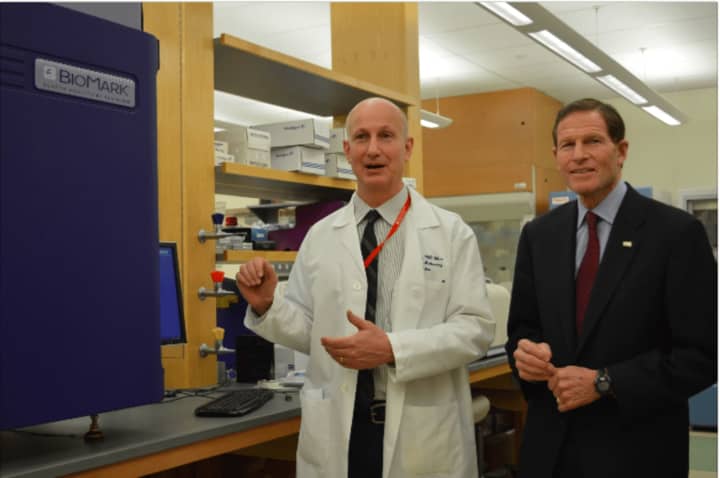“I have been involved in trying to fight Lyme Disease for decades,” said Blumenthal, who explained how this disease is under-diagnosed and underreported.
The federal Centers for Disease Control and Prevention estimates that only one in 10 cases of Lyme are actually reported, he said.
Blumenthal (D-Conn.) visited the Western Connecticut Health Network Biomedical Research Institute in Danbury to discuss that new legislation that he helped design that strives to prevent, detect and educate people on Lyme disease. He also spoke at Stamford Hospital on Wednesday.
The legislation was signed into law last week as part of the 21st Century Cures Act.
The most common sign of Lyme disease, which is spread through tick bites, is an expanding bulls-eye area of red rash. Other early symptoms may include fever, headache and tiredness. In severe cases, symptoms may include loss of facial movement, joint pain, severe headaches with neck stiffness, and heart palpitations, among others. Even with treatment, about 10 percent to 20 percent of people develop joint pain, memory problems, and tiredness for six months.
The more people are made aware of Lyme disease, the more precautions they will take to prevent it, Blumenthal said.
"They will wear the right clothes when they go into the woods, use insect repellent and exercise caution. When they are finished, they will look at themselves and their children [for ticks], because this disease is preventable," he said.
Although the 21st Century Cures Act offers promise, it’s far from the final step in fighting Lyme, he said.
Blumenthal praised Western Connecticut Health Network's research into this disease.
Dr. Paul Fiedler, chair and lab director at the Department of Pathology at the Western Connecticut Health Network, praised the facility.
"We have the organism growing in our laboratory. We dive into the trenches and understand the organism very closely and very deeply," he said of the bacteria that causes Lyme. "We have really focused our efforts at trying to bring the best from around the world to our local environment and attack the problem."
One big concern with Lyme is that currently, there are no reliable methods for detecting it. When patients first experience symptoms, about 70 percent test negative for Lyme, Fiedler said.
“So what we need is a very robust diagnostic test that is accurate and sensitive and specific at the time that the patient first seeks medical attention,” he said. "We want to be able to follow that test result to know when the organism has been cleared from the body. It tends to linger and can take up refuge in the joints in the brain."
Once there is an effective test, researchers and physicians can focus on better treatments, Fiedler said.
“So instead of looking at the body’s response to the infection, we are actually looking for the organism itself in the body and this has proved to be a hugely difficult problem.”
Jennifer Reid, Lyme Community Program Director with the Ridgefield Health Department, spoke about the "BLAST" Lyme Disease Prevention Program she helped to create.
According to the program, those who spend time outdoors should take the following steps to prevent Lyme Disease:
- Bathe or shower soon after outdoor activity
- Look for ticks and remove properly
- Apply insect repellent to skin and clothing
- Spray tick habitat areas in your yard
- Treat pets with veterinarian-recommended products
Click here to follow Daily Voice Danbury and receive free news updates.




